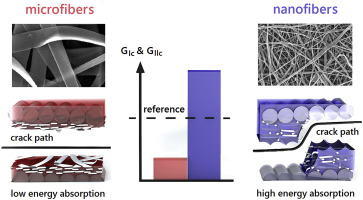当前位置:
X-MOL 学术
›
Compos. Sci. Technol.
›
论文详情
Our official English website, www.x-mol.net, welcomes your
feedback! (Note: you will need to create a separate account there.)
Delamination resistant composites by interleaving bio-based long-chain polyamide nanofibers through optimal control of fiber diameter and fiber morphology
Composites Science and Technology ( IF 8.3 ) Pub Date : 2020-06-01 , DOI: 10.1016/j.compscitech.2020.108126 Timo Meireman , Lode Daelemans , Sander Rijckaert , Hubert Rahier , Wim Van Paepegem , Karen De Clerck
Composites Science and Technology ( IF 8.3 ) Pub Date : 2020-06-01 , DOI: 10.1016/j.compscitech.2020.108126 Timo Meireman , Lode Daelemans , Sander Rijckaert , Hubert Rahier , Wim Van Paepegem , Karen De Clerck

|
Abstract In this work an innovative electrospinning system is proposed that simultaneously has an adequate temperature resistance, a high increase in mode I (+51%) and mode II (+96%) delamination performance and can be commercially produced. Interleaving nanofibrous veils can potentially solve the issue of the limited delamination resistance encountered in composite laminates, but industrial upscaling has always been impeded by one or more critical factors. These constraining factors include a limited temperature stability of the nanofibers, a lack in simultaneous mode I and II delamination performance increase and the complexity of the electrospinning system because non-commercial polymers or specialty nanofibers (e.g. coaxial) are required. In this paper, a robust electrospinning system is proposed that is the first to overcome all major hurdles to make nanofiber toughening industrially viable. A new class of nanofibers based on biosourced polyamide 11 and its poly(ether-block-amide) co-polymers is used to deal with those shortcomings. The nanofibers have tuneable diameters down to 50 nm and cross-section morphologies ranging from circular to ribbon-shaped. The key to this work is the fundamental underpinning of the toughening effect using a broad range of interleaves with different mechanical and thermal properties, fiber diameters and fiber morphologies, all produced from the same bio-based base polymer. Generally, round and thin nanofibers performed better than larger and ribbon-like fibers. The relationship between the fiber morphology and the delamination performance is further underpinned using detailed analysis of the fracture surface. Ultimately, this results in a range of optimized nanofibrous veils capable of improving the delamination resistance considerably without suffering from the aforementioned drawbacks.
中文翻译:

通过纤维直径和纤维形态的优化控制,通过交织生物基长链聚酰胺纳米纤维来制备抗分层复合材料
摘要 在这项工作中,提出了一种创新的静电纺丝系统,该系统同时具有足够的耐温性、模式 I (+51%) 和模式 II (+96%) 分层性能的大幅提高,并且可以商业化生产。交错的纳米纤维面纱可以潜在地解决复合层压板中遇到的分层阻力有限的问题,但工业升级一直受到一个或多个关键因素的阻碍。这些限制因素包括纳米纤维的有限温度稳定性、缺乏同步模式 I 和 II 分层性能增加以及静电纺丝系统的复杂性,因为需要非商业聚合物或特殊纳米纤维(例如同轴)。在本文中,提出了一种强大的静电纺丝系统,该系统首先克服了使纳米纤维增韧在工业上可行的所有主要障碍。一类基于生物源聚酰胺 11 及其聚(醚-嵌段-酰胺)共聚物的新型纳米纤维用于解决这些缺点。纳米纤维的直径可调至 50 nm,横截面形态范围从圆形到带状。这项工作的关键是使用各种具有不同机械和热性能、纤维直径和纤维形态的交错层来巩固增韧效果,所有这些都由相同的生物基基础聚合物制成。通常,圆形和细的纳米纤维比较大的带状纤维表现更好。使用断裂表面的详细分析进一步巩固了纤维形态与分层性能之间的关系。最终,这产生了一系列优化的纳米纤维面纱,能够显着提高抗分层性而不会遭受上述缺点。
更新日期:2020-06-01
中文翻译:

通过纤维直径和纤维形态的优化控制,通过交织生物基长链聚酰胺纳米纤维来制备抗分层复合材料
摘要 在这项工作中,提出了一种创新的静电纺丝系统,该系统同时具有足够的耐温性、模式 I (+51%) 和模式 II (+96%) 分层性能的大幅提高,并且可以商业化生产。交错的纳米纤维面纱可以潜在地解决复合层压板中遇到的分层阻力有限的问题,但工业升级一直受到一个或多个关键因素的阻碍。这些限制因素包括纳米纤维的有限温度稳定性、缺乏同步模式 I 和 II 分层性能增加以及静电纺丝系统的复杂性,因为需要非商业聚合物或特殊纳米纤维(例如同轴)。在本文中,提出了一种强大的静电纺丝系统,该系统首先克服了使纳米纤维增韧在工业上可行的所有主要障碍。一类基于生物源聚酰胺 11 及其聚(醚-嵌段-酰胺)共聚物的新型纳米纤维用于解决这些缺点。纳米纤维的直径可调至 50 nm,横截面形态范围从圆形到带状。这项工作的关键是使用各种具有不同机械和热性能、纤维直径和纤维形态的交错层来巩固增韧效果,所有这些都由相同的生物基基础聚合物制成。通常,圆形和细的纳米纤维比较大的带状纤维表现更好。使用断裂表面的详细分析进一步巩固了纤维形态与分层性能之间的关系。最终,这产生了一系列优化的纳米纤维面纱,能够显着提高抗分层性而不会遭受上述缺点。











































 京公网安备 11010802027423号
京公网安备 11010802027423号